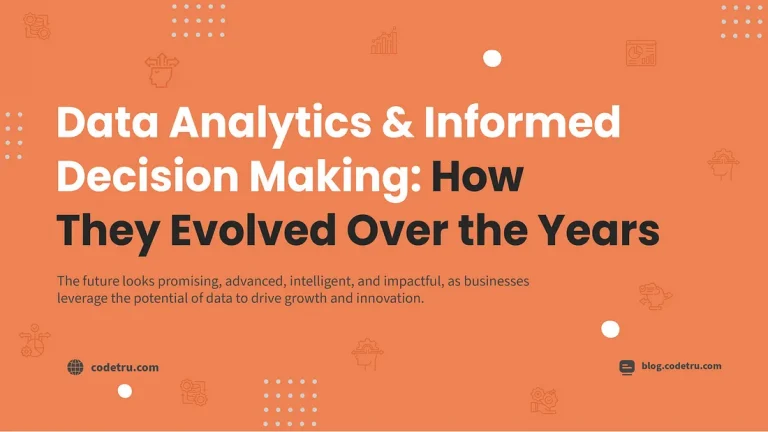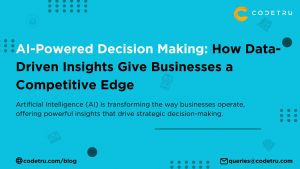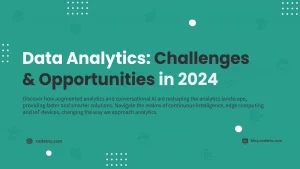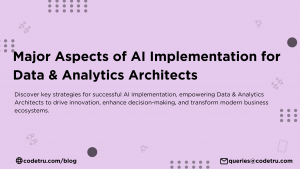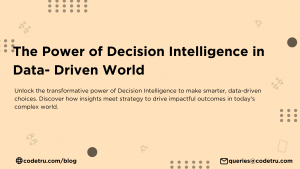In today’s rapidly evolving business landscape, data and analytics have become indispensable tools for driving growth and innovation. Over the years, their role has evolved significantly, allowing companies to make more data informed decisions, predict future data analytics trends, and communicate insights effectively.
Data and analytics are the backbone of informed decision-making in the business world. They provide organizations with the ability to collect, process, and analyze vast amounts of data, ultimately empowering them to make strategic choices that can lead to growth and innovation.
Data-Driven Decision Making
Data-informed decision making is the process of using data to make better business decisions. It can help businesses reduce risks, increase efficiency, enhance customer satisfaction, and achieve higher performance. It can be applied to various aspects of business, such as marketing, sales, finance, operations, human resources, and more to get a higher ROI.
According to a recent survey by Gartner, 91% of organizations have not yet reached a “transformational” level of maturity in data and analytics indicating that there is still a lot of room for growth in this area.
Companies Using Data-driven Decision-making
Netflix
Netflix uses data analytics-informed decision-making to personalize its recommendations, optimize content, and improve the overall user experience. They analyze billions of data points every day, such as what users watch, when they watch, how they watch, and what they rate. Netflix then uses this data to create algorithms that can suggest the best content for each user, based on their preferences, behavior, and context.
Amazon
Amazon is known to use its data to enhance its e-commerce, cloud computing, and artificial intelligence businesses. By leveraging data-informed decision-making, Amazon provides personalized recommendations, improves delivery systems, and develops products such as Alexa and AWS based on customer preferences and needs.
The Benefits of Data-Driven Decision Making are:
- Improved Accuracy: Using data-informed decisions, businesses can validate their hypotheses and measure results with increased accuracy and confidence.
- Enhanced Efficiency: Decisions backed by data analysis decision making streamline processes, saving time and resources.
- Enhanced Customer Experiences: Understanding customer behavior through data analytics informed decision making tailors services to customer needs, boosting satisfaction and loyalty.
Predictive Analytics
Predictive analytics is the process of using data and analytics to predict future outcomes and trends. Predictive analytics can help businesses anticipate and prepare for future events, scenarios, and behaviors. It can be applied to various domains, from customer retention, to fraud detection, risk management, demand forecasting, and more.
Companies Using Predictive Analytics to Drive Growth are:
Starbucks
Starbucks uses predictive analytics and data-informed decision-making to optimize its store locations, menu offerings, and customer loyalty. They analyze data from their customers, such as their demographics, preferences, transactions, and feedback. It then uses this data to create models that can predict the best locations for new stores, based on factors such as traffic, population, and competition. and to create models that can predict the best menu items for each store, based on factors such as seasonality, weather, and local tastes.
Spotify
Spotify has been using predictive analysis for over two decades to personalize its music streaming service, and to create new features and products They use the insights to create algorithms that can recommend the best songs, artists, and genres for each user, based on their preferences, mood, and context. Spotify also uses this data to create features and products, such as Discover Weekly, Release Radar, and the much anticipated Spotify Wrapped each year, that can help users discover new music, stay updated with their favorite artists, and reflect on their listening habits.
According to a report by Forbes, the global predictive analytics market is expected to grow from $7.2 billion in 2020 to $21.5 billion by 2027. This indicates that predictive analytics is becoming an increasingly important tool for businesses.
Data Visualization
Data visualization is the art of presenting complex data in a visual and comprehensible manner. It allows decision-makers to quickly grasp insights from data and communicate their findings effectively within an organization.
It can be used to tell stories, highlight patterns, reveal insights, and inspire actions, using visual elements.
Companies Using Data Visualization
Airbnb
Airbnb utilizes data-informed decision-making to empower hosts and guests. It collects and analyzes data from its platform, such as bookings, reviews, ratings, and searches, and uses this data to create dashboards and reports that can help its hosts and guests make better decisions, such as pricing, availability, and demand. Airbnb’s data visualization capabilities have helped it become the world’s largest online marketplace for travel, with over 4 million hosts and 800 million guests.
The New York Times
The New York Times, possibly the biggest newspaper in the world, collects and analyzes data from various sources, such as public records, surveys, polls, and social media to keep its readership up and to provide its audience with the latest news
The Benefits of Data Visualization are
- Improved comprehension: Data visualization can help businesses make sense of large and complex data sets, using visual elements. It also simplifies and summarizes the data and insights, using visual elements.
- Enhanced communication: Visualising data can help businesses convey and deliver their ideas in an effective and efficient way.
- Increased persuasion: Data visualization can help businesses influence and persuade their audience to take action, using visual elements by highlighting the key points and messages of their data and insights, using visual elements.
The Future of Data and Analytics
The field of data and analytics is constantly evolving and innovating, as new technologies, methods, and applications emerge. The future promises to be more advanced, intelligent, and impactful, as businesses leverage the potential of data to drive growth and innovation.
According to a report by Gartner, the top 10 data and analytics trends for 2023 include augmented analytics, data fabric, and explainable AI. These trends are expected to have a significant impact on the way businesses use data and analytics to drive growth and innovation.
Augmented Analytics
Augmented analytics uses AI and machine learning to enhance data-informed decisions, enabling businesses to act on insights faster and democratize data access. With Augmented analytics businesses can access, understand, and act on their data faster and easier, using natural language processing, computer vision, and voice recognition. It can also help businesses generate and explain insights, recommendations, and predictions, using natural language generation, sentiment analysis, and anomaly detection. Another way Augmented Analytics can help businesses is by democratizing and scaling their data and empowering their users to become more data-driven.
Data fabric
Data Fabric is a unified and integrated platform that can manage, process, and deliver data and analytics across different sources, systems, and environments. It can help businesses create and maintain a consistent and reliable data and analytics infrastructure and optimize their performance and efficiency.
Explainable AI
Explainable AI is the ability of artificial intelligence and machine learning models to provide transparent and understandable explanations of their outputs, behaviors, and decisions. It can help businesses increase the trust, confidence, and accountability of their solutions, using techniques such as feature importance, model visualization, and counterfactual analysis. Another huge advantage of this is that businesses can comply with the ethical, legal, and regulatory standards and requirements of their data and analytics solutions, using techniques such as fairness, privacy, and security.
Conclusion
According to a report by McKinsey, companies that effectively use data and analytics are significantly more likely to achieve higher profitability and customer retention. Data-informed decision making is not just a trend but a necessity for businesses looking to thrive in today’s competitive market.
By leveraging tools and methodologies like predictive analytics and adopting a data analysis decision-making approach, companies can better understand their customers, optimize operations, and innovate solutions that drive growth and success.
FAQs About Data Analytics & Informed Decision-Making
1. How has data analytics evolved over the years?
Data analytics has evolved significantly from basic data collection and reporting to advanced techniques involving big data, machine learning, and predictive analytics. Early methods focused on simple data aggregation, while modern analytics leverage sophisticated algorithms and AI to derive insights from large and complex datasets. This evolution has enabled more accurate forecasting, deeper insights, and better decision-making across industries.
2. What role does predictive analytics play in decision-making today?
Predictive analytics plays a crucial role in modern decision-making by using statistical models and machine learning algorithms to forecast future trends and behaviors. By analyzing historical data, businesses can predict outcomes, identify potential risks, and make informed decisions that optimize strategies and improve operational efficiency. This proactive approach helps organizations stay ahead of trends and make data-driven decisions.
3. How has the integration of artificial intelligence (AI) changed data analytics?
The integration of artificial intelligence (AI) has revolutionized data analytics by enabling more sophisticated data processing, analysis, and interpretation. AI technologies, such as machine learning and natural language processing, enhance the ability to uncover patterns, automate data analysis, and generate actionable insights. This has made data analytics more powerful, efficient, and accessible, allowing organizations to make better-informed decisions.
4. What are the benefits of using big data in decision-making processes?
Big data provides significant benefits in decision-making by offering a vast volume of information that can be analyzed for deeper insights. The ability to process and analyze large datasets allows businesses to identify trends, correlations, and patterns that were previously hidden. This comprehensive view improves accuracy in predictions, enhances strategic planning, and enables more personalized customer experiences.
5. How has data visualization technology impacted the way we interpret data?
Data visualization technology has greatly impacted data interpretation by transforming complex data into visual formats, such as charts, graphs, and dashboards. This visual representation makes it easier to understand and analyze data patterns, trends, and relationships. Enhanced data visualization tools improve communication, facilitate better decision-making, and allow stakeholders to grasp insights quickly and effectively.

